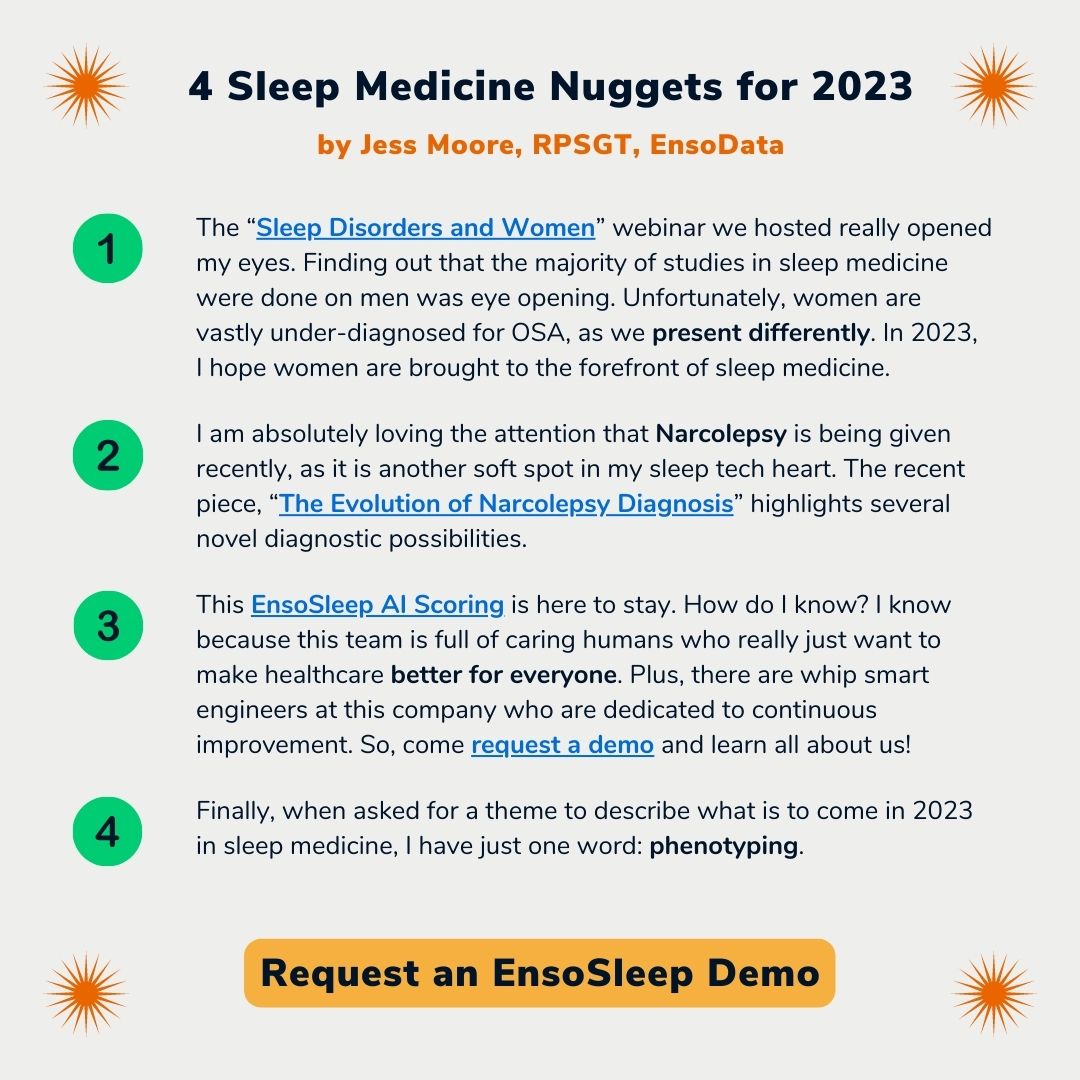Meet our sleep story feature of the month, an RPSGT turned EnsoData sales manager, who went from improving patient outcomes on a 1:1 level to a 1:many scale
In another rendition of Meet the EnsoData Clinician, we’re highlighting one of our Regional Sales Managers, Jessica Moore, RPSGT. With 20 years of experience as a sleep technologist, including time as a lead tech and a clinic coordinator, Jess experienced the technological advances of sleep medicine firsthand, from the automation of CPAP machines to the rise of home sleep testing. In her new role at EnsoData, Jess helps her fellow sleep techs spend less time in front of the computer and find more time for patient education, sleep navigation and compliance programs. Let’s learn a little more about her passion for sleep medicine.Falling into Sleep Medicine
After college, Jess traveled the U.S., with stops in Hawaii, Seattle and Los Angeles before moving back home to Michigan. With a lifetime interest in medicine, and a B.S. in Health Management, Jess naturally looked for positions within the healthcare industry. The hospital in Iron Mountain, Michigan (part of the Upper Peninsula of Michigan) was looking for a new sleep technologist for their on-the-job training (OJT) program. She thought the position sounded interesting, and so she applied for the OJT sleep tech role. It was a life changing decision. In the new job, Jess was fortunate enough to train under a trio of RPSGTs and an amazing sleep doctor and pulmonologist.“I was an OJT that was taught by 3 of the most amazing RPSGTs I’ve ever met. They instilled in me a desire to learn as much as possible and to be a great sleep tech,” said Moore. “Those techs and the sleep physician I worked for changed my life and allowed me to have this amazing career taking care of people and improving their quality of life.”From there, Jess moved to West Virginia, to work at Jefferson Memorial Hospital. In the 15+ years Jess was employed at the hospital, it transitioned first to the Jefferson Medical Center and then eventually to WVUH-East. She began there as a technologist, eventually taking on a clinic coordinator role and lead tech. In both roles, Moore’s favorite work was patient-facing: performing sleep studies and EEG’s and providing patient education throughout the extended process. While she also scored studies and performed other non-patient facing tasks, improving patient outcomes has always been her top priority.
“Always fight for your patients. I remember all the hugs, cards, kind words and tears I’ve gotten over the years, that is why we do it,” she said.
Improving Patient Care is Her Passion Point
While Jess could share patient care stories for hours, one story came to mind that always gets to her. Let’s call the patient Robert. When his split-night was denied, Robert received a full PSG. Jess marked 810 apneas during the test, all with major desaturations and arousals.“Not only did Robert have severe sleep apnea,, but he also suffered from the loudest bruxism I’ve ever heard,” shared Moore. “It was kind of like the squeaking sound of a thirty year old metal spring bed.”When Jess showed Robert his results the next morning, they could hear the bruxism on the audio clip. He started to cry and she asked him what was wrong. Robert’s wife had passed away the year before, and all he could think about was the years that she slept next to him and had to listen to that. He felt a tremendous amount of guilt.
“It is why I have always been a huge advocate for the bed partner and always address them in my sleep education. Robert, by the way, went on to a very successful CPAP titration and not only did the apneas stop, but so did the bruxism,” added Moore.Ultimately, Robert’s story is just one example of the patient care connection that inspires Jess regularly. The ability to share positive patient outcomes with more technologists brings her joy.
Patient Education and AI Scoring Go Hand in Hand
We all know that poor sleep affects every part of daily life. It is difficult to be healthy without adequate sleep. Yet, many people don’t know they even need a sleep test. When you add in the massive shortage of sleep technologists, you get a confluence of problems challenging sleep professionals. However, one possible solution is finding more professionals who are providing sleep education. That’s partly why Jess joined EnsoData.“The times in my career that I made the biggest difference were when I was face to face with a patient, not sitting in front of a computer scoring,” said Moore.In her conversations with private sleep labs and large health systems alike, she emphasizes the importance of 1:1 connections with patients. It’s a message that resonates with techs across the board, and it’s why she joined the EnsoData team.
“While I do miss working with patients, it is also very satisfying to know that I have a part in speeding up their diagnosis and treatment with consistent and timely scoring,” said Moore. “I also know there is a team of whip smart engineers at this company who are dedicated to continuous improvement. So, come request a demo and learn all about us!”Couldn’t have said it better, Jess! Connecting with and listening to patients is one way to improve outcomes! And with that, we’ll wrap this up with a quick infographic from Jess on four things to know about sleep medicine for 2023.






